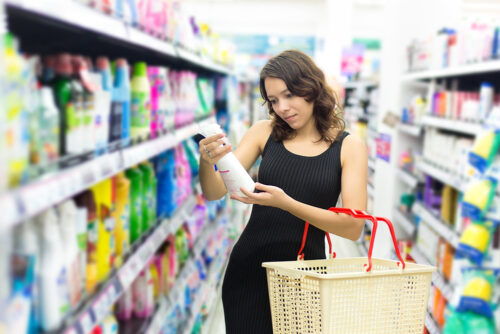
Woman buys washing powder
Companies that manufacture and distribute certain finished cleaning products sold in California should be aware of California’s Cleaning Product Right to Know Act (“the Act”), passed in October 2017, which changes the requirements for product labels and corresponding websites. Such companies have until January 1, 2020 to update online information for each product and until January 1, 2021 to update product labels.
What Does California’s Cleaning Product Right to Know Act Require?
The Act applies to certain finished cleaning products, including air care products, automotive products, general cleaning products, and polishes or floor maintenance products used primarily for janitorial, domestic or institutional cleaning purposes.
The following information must be disclosed on cleaning product websites by January 1, 2020:
- Intentionally added ingredients, listed in descending order of predominance by weight.
- Nonfunctional constituents present in the product at a concentration of 0.01% or greater.
- The Chemical Abstracts Service (CAS) number for any intentionally added ingredient or nonfunctional constituent listed shall be listed with each; if the CAS number is not available or an ingredient is confidential business information, the CAS number must be cited as “not available” or “withheld,” respectively.
- The functional purpose served by each intentionally added ingredient.
- Links for designated lists grouped together in a single location.
- Links to the product’s hazard communication safety data sheet.
- For fragrance ingredients, additional information must be disclosed.
The following information must be disclosed on cleaning product labels by January 1, 2021:
- Intentionally added ingredients (either with a functional or technical effect) contained in the final product that are included on any of the 22 designated lists defined in section (g) of the Act.
- Intentionally added ingredients which are not confidential business information.
- To protect such information, a company may cite a generic chemical name.
- The company’s toll-free telephone number and web site address.
- If a product label’s list of intentionally added ingredients is incomplete, the company must include a statement that reads “For more ingredient information, visit WEBSITE.”
Cleaning is essential to protecting our health in our homes, schools and workplaces.
Household and cleaning products often include harmful chemicals. Even products advertised as “green” or “natural” may contain ingredients that can cause health problems. Some cleaning supplies can even be flammable or corrosive. Fortunately, you can limit your exposure to those risks. Read all labels and follow instructions when using cleaning products. It could save your life.
Many cleaning supplies or household products can irritate the eyes or throat, or cause headaches and other health problems, including cancer. Some products release dangerous chemicals, including volatile organic compounds (VOCs). Other harmful ingredients include ammonia and bleach. Even natural fragrances such as citrus can react to produce dangerous pollutants indoors.
VOCs and other chemicals released when using cleaning supplies contribute to chronic respiratory problems, allergic reactions and headaches. Studies are underway to assess how these chemicals affect people who have asthma and other respiratory illnesses.1 However, past studies link exposure to chemicals from cleaning supplies to occupational asthma and other respiratory illnesses.2,3
Cleaning supplies and household products containing VOCs and other toxic substances can include, but are not limited to:
- Aerosol spray products, including health, beauty and cleaning products;
- Air fresheners;
- Chlorine bleach*;
- Detergent and dishwashing liquid;
- Dry cleaning chemicals;
- Rug and upholstery cleaners;
- Furniture and floor polish; and
- Oven cleaners.1,2